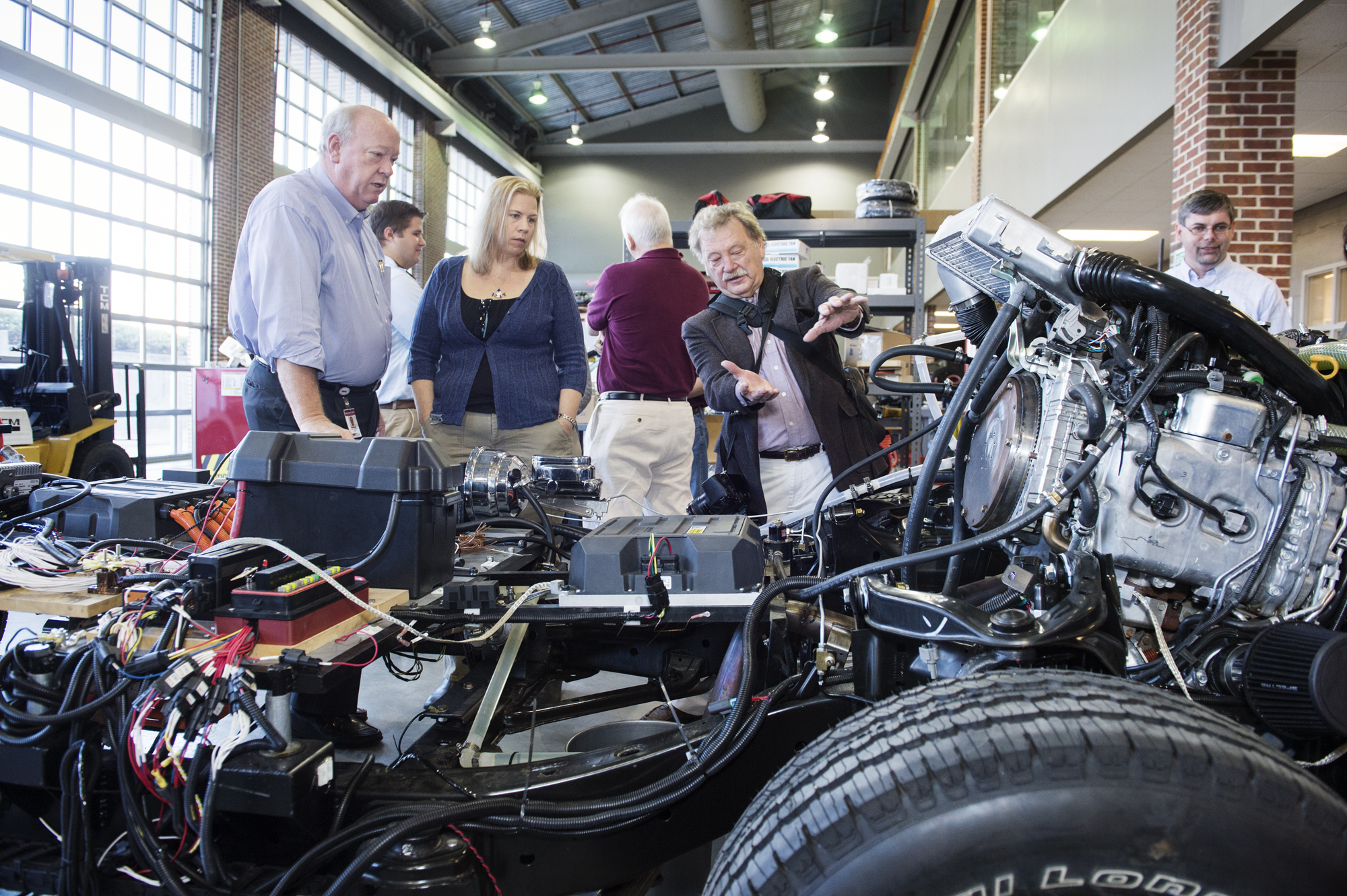Contact: Allison Matthews

Photo by: Megan Bean
STARKVILLE, Miss.--Faculty and students at Mississippi State's Center for Advanced Vehicular Systems this month showcased several developments to visitors from the Environmental Protection Agency and the Mississippi Department of Environmental Quality who wanted to learn about environmentally-friendly innovations at the university.
Zach Rowland, MSU deputy director of CAVS, said MSU faculty and students affiliated with the center enjoy showcasing Mississippi State's capabilities relative to automotive engineering and the current innovations that will reduce the overall carbon footprint of vehicles in the future.
The tour of CAVS research facilities included the materials analysis lab, a mechanical testing facility, advanced engine combustion lab, and human factor studies lab complete with a driving simulator.
"We have a history with EPA and we hope to build an even stronger bond," Rowland said.
Katy Lusky, section chief of air quality modeling and transportation in EPA's air, pesticides and toxics management division, said the first-hand look at university research conducted at CAVS was encouraging.
Lusky's colleagues Dale Aspy and Alan Powell accompanied her on the visit, and MDEQ representative Keith Head of the air division joined the EPA team. Also on the tour were MSU mechanical engineering alumnus Freddie Ervin, now an MDEQ air division employee, and Ricky Dye, a current MSU student spending the fall semester on a cooperative education assignment with MDEQ. Dye, a Columbus native, is a civil engineering major.
"We've had a relationship in the past with the MSU students from CAVS and we wanted to see first-hand what they are working on. We've had a lot of research discussions and updates on quite a few different projects," Lusky said.
"EPA is interested in anything that's going to advance technology and reduce emissions," she added. "We think all the work that they do here is very impressive."
The visit came on the heels of a previous interaction between EPA officials and MSU students who participated this fall in an EPA display booth at the Petit Le Mans race, a sports car endurance test held annually at Road Atlanta in Braselton, Georgia. It has become a showcase for the latest developments in automotive technology.
The MSU student team demonstrated CAVS work on "Car of the Future," a project with a mission to lead in vehicle performance and energy efficiency and funded by James Worth "Jim" Bagley, a 1961 and 1964 MSU electrical engineering alumnus and major university benefactor who also is the namesake of the university's engineering college.
Rowland said that in this pioneering project, the vehicle looks like a typical crossover SUV, but its engine is not connected to the wheels like conventional automobiles. Instead, the engine drives a generator that powers the electric drive motors which drive the wheels and an advanced energy storage system that provides additional power for performance.
In addition to "Car of the Future," other projects presented to the guests included, among others, student-driven advanced vehicle technology competition vehicles and idle reduction technology developments to reduce diesel emissions.
Matthew Doude, a CAVS research associate who as a student worked on advanced vehicle technology competition teams, said the level of competition now is "unbelievable" as students are challenged to push the boundaries of new environmentally-friendly technologies while still maintaining standards of vehicle performance and other factors. MSU teams have consistently performed well in the prestigious and exclusive challenges.
Established by the U.S. Department of Energy and General Motors, the competitions are managed by Argonne National Laboratories with only 15 universities invited to participate each year.
Doude said MSU's current student team is finishing the first semester of the EcoCAR 3 competition. During a four-year span, the team will redesign a Chevrolet Camaro as a hybrid vehicle with the goals of reducing energy consumption and emissions. While accomplishing these innovations, the team also must maintain consumer acceptability in the areas of performance, utility and safety, as well as weighing costs.
"We've got to meet energy and environmental goals, while considering cost and innovation," said Wesley Haney, a senior mechanical engineering major from Amory.
Haney and fellow EcoCAR 3 team member Casey McGee, a senior communication/public relations major from Starkville, were on hand to give visitors information about CAVS from the student perspective.
McGee said the student team includes nearly 100 students representing more than 15 majors. The students comprise sub-teams focusing on mechanical, electrical, controls, modeling and simulation, communication, and project management with the common goal of designing, validating and building the competition vehicle at the university.
Rowland said that much of the past successes have been because of the sheer determination of MSU students in this area.
"A large portion of this is driven by passion, and that's one factor that's given us an advantage over other schools," Rowland said.
Mike Mazzola, professor and endowed chair of electrical and computer engineering, agreed adding, "These students have done more than anything to make Mississippi State University a place with an automotive engineering culture."
Mazzola said that while automotive engineering is at the forefront of CAVS work, the center's overall effort is focused on developing superior computational, engineering, manufacturing, design, and information technologies relevant to a variety of Mississippi and regional industries. The interdisciplinary center is comprised of research, engineering design and development, and technology transfer teams for industry and government partners.
For more on CAVS, visit http://www.cavs.msstate.edu/.
Mississippi's flagship research university is online at www.msstate.edu, facebook.com/msstate, instagram.com/msstate and twitter.com/msstate.